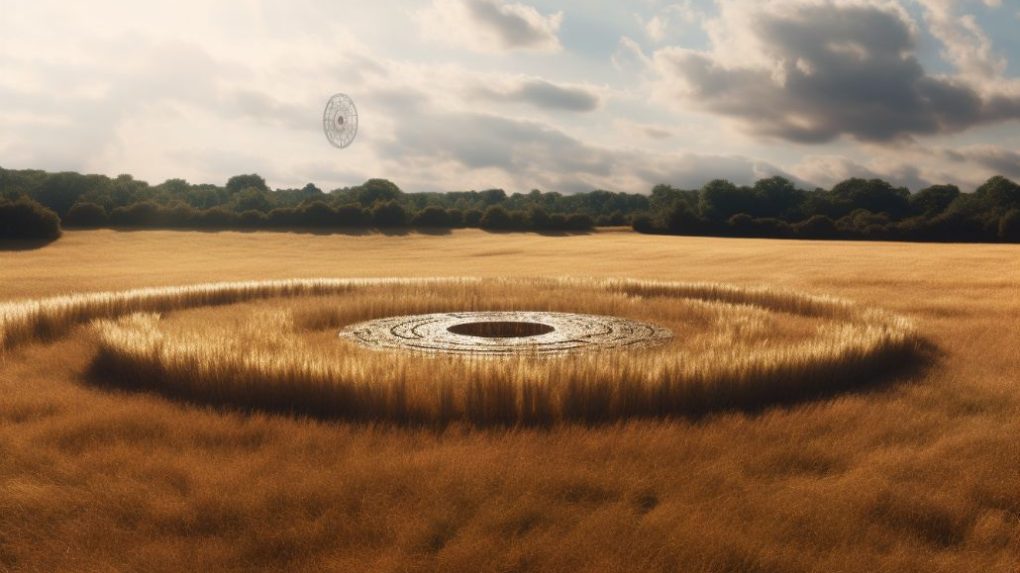Crop circles have always been a topic of great interest among people around the world. These mysterious formations in crop fields have been the subject of much debate and speculation, pitting skeptics against those who believe the circles are evidence of extraterrestrial activity or other paranormal phenomena.
In this article, we will explore the phenomenon of genuine crop circles and document some of the most impressive cases worldwide.
What Are Crop Circles?
Crop circles are circular areas of flattened crops in wheat fields that can be elaborate and intricate in their designs. These formations have been appearing in crop fields for centuries, but not until the 1970s did they gain widespread attention in the media. Modern crop circles are often complex patterns that suggest high precision and skill in their creation.
Crop circles have been recorded throughout history, with some examples dating back to the 17th century. However, the phenomenon gained significant attention in the late 20th century, particularly in southern England, where many crop circles have been documented. In the 1980s and 1990s, there was a surge in crop circle formations, and it was during this time that crop circle researchers began investigating the phenomenon more closely.
Also read Dragon Tales: Myths and Legends from Around the World
The Most Impressive Real Crop Circles
Crop circles have fascinated people around the world for decades. These mysterious formations, often found in fields of crops, have sparked numerous theories and debates about their origins and meanings. While human artists likely create some crop circles, others exhibit intricate designs and patterns that are difficult to explain.
There have been many famous crop circle formations over the years. Here are some of the most impressive crop circles in history:
The Milk Hill Formation in Wiltshire, England
Discovered in 2001, the Milk Hill Formation is renowned for its immense size and complex design. It features a six-armed spiral that radiates from the center, creating an awe-inspiring visual spectacle. This formation is an example of one of the largest and most elaborate crop circles ever recorded.
The Crabwood Formation in Hampshire, England
Discovered in 2002, the Crabwood Formation gained attention due to its depiction of an alien face alongside a binary code message. The message, when translated, allegedly contained a warning about the dangers of nuclear weapons. Many consider this formation to be evidence of extraterrestrial communication.
The Chilbolton Formation in Hampshire, England
Discovered in 2001, the Chilbolton Formation showcases a complex pattern resembling a fractal image known as the Julia Set. Its intricate design perplexed researchers, as the level of detail seemed beyond the capabilities of human circle makers. This formation raised questions about the potential involvement of unknown forces.
The Mowing Devil Legend and Formation in Hertfordshire, England
The Mowing Devil formation is steeped in legend and is one of the earliest recorded instances of a crop circle. According to the story, a farmer made a pact with the devil to have his field mowed overnight one night. The next morning, the field was discovered flattened in a circular pattern, giving rise to tales of supernatural involvement.
The Cley Hill Formation in Wiltshire, England
Discovered in 2017, the Cley Hill Formation exhibits a breathtaking design comprising 16 circles arranged in a complex pattern. This formation’s precision and attention to detail captivated researchers and onlookers alike, leaving them in awe of the mystery behind its creation.
While these crop circles represent just a handful of notable examples, millions of documented formations worldwide exist. England’s southern counties, in particular, have been hotspots for crop circle activity. Researchers and enthusiasts often flock to these areas during the peak season to investigate new formations, collect data, and contribute to the ongoing exploration of these enigmatic creations of nature.
You may also like Legends of the Jersey Devil – Fact or Folklore?
The Science of Crop Circles
While the origin of crop circles remains debatable, there are various aspects to consider when exploring the phenomenon. Despite numerous theories, many researchers lean towards the notion that crop circles are primarily man-made. The tools utilized in their creation are relatively simple, including ropes, boards, and even makeshift devices like a baseball cap fitted with wire loops. However, crafting intricate formations and complex crop circles can be time-consuming, often spanning hours or days, demanding remarkable skill and precision.
While some individuals attribute crop circles to extraterrestrial or paranormal entities, scientific evidence supporting such claims is lacking. Skeptics maintain that crop circles are essentially an art form, originating from human circle makers who relish the challenge of designing and implementing elaborate patterns within crop fields.
Among the scientific explanations proposed, one intriguing theory centers around electrostatic induction. According to this hypothesis, the energy generated by passing electrical storms can induce a magnetic field. This magnetic field then interacts with the metal particles in the soil, temporarily magnetizing them. As a result, the plants within the affected area may become flattened in a circular pattern, giving rise to the intricate formations commonly observed as crop circles.
However, it’s important to note that the crop circle phenomenon is multifaceted and continues to captivate scientific researchers and curious onlookers. While the man-made origin theory prevails, the allure of crop circles depicting unexplained intricacies and the occasional presence of anomalous characteristics continue to fuel ongoing investigations into the realm of crop circles.
Documenting Crop Circle Season
Crop circles have a seasonal presence, typically emerging during the summer months, particularly in the picturesque landscapes of southern England, where vast fields of wheat, barley, and corn provide the canvas for these enigmatic formations. While the appearance of crop circles does not follow a rigid pattern, the peak season for their occurrence generally spans from June to August, coinciding with the growth and maturity of the crops.
Crop circle researchers employ various tools and techniques to capture and document these transient creations. Aerial photography has proven invaluable for observing and analyzing the intricate patterns and shapes that create crop circles that adorn the fields. Drones equipped with high-resolution cameras soar above the crop circles, capturing detailed images and videos from once inaccessible vantage points. This aerial perspective allows researchers to comprehensively view the formations, capturing their full extent and intricacies.
Advanced aerial photography equipment enables researchers to identify new formations as they emerge promptly and document their characteristics in real-time. By meticulously recording the patterns and shapes from different angles and altitudes, researchers can scrutinize the crop circles’ symmetry, precision, and complexity. This documentation aids in distinguishing between naturally occurring phenomena, such as crop lodging due to weather conditions, and deliberate human-made formations.
Additionally, advanced imaging techniques such as thermal imaging and LiDAR (Light Detection and Ranging) are employed to detect any irregularities or anomalies associated with crop circles. These tools offer further insights into the affected crops’ structural changes and energy patterns, providing additional clues about the mechanisms behind their formation.
By employing modern technology and a systematic approach to documentation, researchers are better equipped to unravel the mysteries surrounding crop circles. This comprehensive understanding of crop circle research allows for detailed analyses and comparisons between different formations, ultimately contributing to the ongoing exploration and scientific study of these intriguing phenomena.
Don't miss The Truth Behind the UFO Lights: Debunking Myths and Unraveling Mysteries
Creating Crop Circles
Crafting a crop circle involves flattening crops in a circular pattern, transforming fields into intricate formations. The complexity of the process can range from basic circular shapes to elaborate patterns and designs, with creators utilizing various tools and techniques. Some crop circle makers rely on pre-planned arrangements and computer software to meticulously execute their vision, while others prefer a more spontaneous approach, designing patterns on the fly.
The legality and ethics surrounding crop circle creation remain subjects of ongoing debate. While sure farmers embrace the presence of crop circle makers on their land and even leverage the phenomenon as revenue through admission fees for visitors to simple circles, others view it as a form of trespassing and disruption to their agricultural operations.
A shift has emerged in recent years towards using non-destructive methods to produce crop circle-like designs. This evolution reflects a desire to maintain the aesthetic appeal and intrigue associated with crop circles while minimizing the impact on the crops. One unique approach involves harnessing GPS (Global Positioning System) technology to guide the creation of designs that can be viewed and appreciated from an aerial perspective without needing to flatten crops physically. This innovative technique allows for the developing of intricate and captivating patterns that remain visually striking when seen from above.
By embracing non-destructive methods, crop circle enthusiasts seek to balance their artistic expression with respect for the agricultural environment and the landowners’ rights. This approach broadens the possibilities for creative exploration within the realm of crop circles, showcasing that the allure and impact of these formations can be achieved without compromising the integrity of the earth, the crops, and the farming practices.
While the artistry of crop circles continues to captivate and intrigue, the discussion surrounding their creation encompasses an array of perspectives containing legal, ethical, and creative considerations. The evolving techniques employed by crop circle makers reflect their dedication to preserving the mesmerizing beauty of these formations while navigating the complex landscape of land use, artistic expression, and respect for agricultural livelihoods.
The Effects of Crop Circles on Plants and Soil
One of the most exciting aspects of crop circles is their effect on the plants and soil. Research has shown that crops within a crop circle grow faster and taller than those outside. This is believed to be due to the increased levels of nutrients and minerals in the air and soil within the circle.
Some researchers have also suggested that the electromagnetic fields generated by crop circles may affect the growth of plants within the circle. Others have hypothesized that the circles are created by a process of resonance, in which sound waves or other vibrations cause the plants to flatten in a circular pattern.
The Controversy Surrounding Crop Circles and Hoaxes
The phenomenon of crop circles has been surrounded by controversy since its inception. While many believe that the circles are evidence of extraterrestrial activity or other paranormal forces, others are skeptical of these claims.
One of the main reasons for this skepticism is that many crop circles have been proven to be hoaxes. In 1991, Doug Bower and Dave Chorley claimed responsibility for creating many crop circles in southern England. They used simple tools and techniques to create circles in crop fields and even sold t-shirts featuring designs based on their crop circles.
Since then, many other human circle makers have claimed responsibility for crop circles worldwide. However, there are still many formations that remain unexplained and continue to spark debate and speculation.
Conclusion
There is no doubt that crop circles are a fascinating and mysterious phenomenon. While most experts agree that they are man-made, the skill and precision required to create some more complex formations are awe-inspiring.
Whether you believe that crop circles are evidence of extraterrestrial activity, aliens, or simply a form of art, there is no denying that they continue to capture the imagination of people worldwide. As technology advances and our understanding of the phenomenon grows, we may finally be able to unravel the mystery of crop circles once and for all.
Recommended Further Reading:
Auto Amazon Links: No products found.



